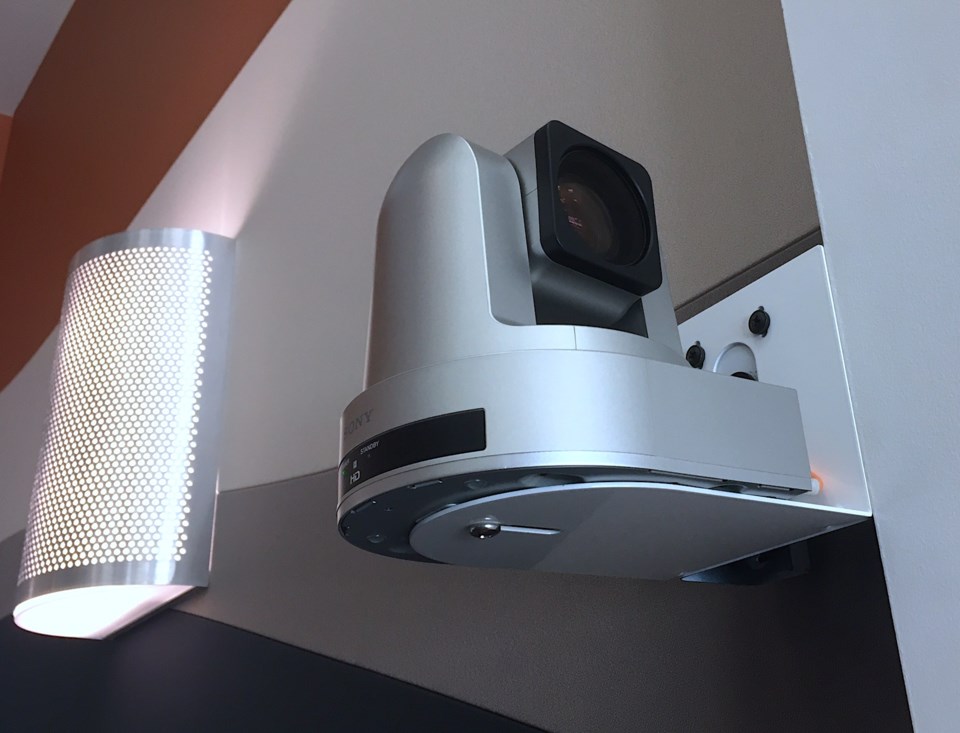SUNDRE — The municipality’s recently upgraded council chambers is now future-ready and fully equipped with three webcams to eventually begin broadcasting meetings in real-time.
Three cameras that pivot and zoom to capture essentially all of the room’s angles will also focus in on the person who’s speaking, determined by whichever microphone is active during a discussion, said Chris Albert, director of corporate services, adding the cameras can also provide a wide angle view when no microphones are in use.
“All of that is built into the capabilities of the system. So, it’s planning for the future,” Albert said on Friday, May 6 during an interview at his office. “We are completely future-ready.”
But aside from some regulatory considerations that must be accounted for prior to officially launching public broadcasts of council meetings, he added live-streaming is also “very much dependent on the broadband connectivity that is coming in the very near future, and our ability to use that signal.”
So, although the technology to broadcast meetings has been installed, the municipality doesn’t yet have sufficient high-speed internet service.
“We just don’t have the capacity right now,” said Linda Nelson, chief administrative officer.
That means the project for the time being remains on the back burner until Xplornet completes the deployment of its fibre-to-the-premise high-speed broadband infrastructure.
“Council would look at it again at that point,” said Nelson.
While an estimated timeline remains elusive, Albert said the project could reasonably be expected to be ready by the fall of 2023.
“It’s probably too early right now to give a definitive timeline,” said Albert. “But I would say a year is probably not being overly optimistic. If all the stars align, we could probably have it within the year.”
In the meantime, Nelson extends an invitation to any residents who are interested in following council proceedings to join the in-person meetings.
“We would certainly encourage our electors to participate in our once-again live council meetings,” she said.
COVID grant boosts modest plans
Prior to the pandemic, the municipality had already begun investigating options to modernize the council chambers with a new layout and furniture.
“We had originally planned a modest $40,000 upgrade out of our own money,” said Albert. “Which was really just to slightly improve the layout and the desks and improve the microphones a little bit—no cameras, no control over the microphones. It would have been similar to the old system that we had.”
But when the provincial government announced funding through the Municipal Operating Support Transfer grant program for municipalities across the province to provide economic stimulus amid the pandemic and determined the project qualified, the municipality did not hesitate.
“Council chambers and making it future-ready was one of the available initiatives,” he said. “So, we took advantage of that.”
In the end, the project’s cost was completely paid for by the Alberta government.
“It was entirely covered by COVID grant funding from the province,” he said. “The full project—the furniture, the layout, the partitions, the microphones, the cameras—the total all-in cost was $105,921.03.”
That represented something of a boost for the municipality, which received funding not only for the COVID-19 partitions that had to be installed, but also the upgrades to make the chambers future-ready complete with webcams.
“It was very handy,” said Albert.
Once broadband eventually goes live, he added there will remain the final logistical hurdle of determining how to allow open access so the public can tune in while also allowing for council and administration to track attendance and ensure meetings remain a completely open forum similar to in-person council meetings.
Plexiglas partitions in storage
Although the Plexiglas partitions that were installed as part of the provincial government’s guidelines to enable a return to in-person council meetings have been removed, the see-through shields will remain in storage indefinitely in the event they’re ever needed again, said Nelson.
“We will keep them in storage, because we still don’t know what’s going to happen,” she said. “We are optimistic and hoping that we won’t need to use them again, but I think it would be smart from a risk-management perspective to keep those in storage.”
At the time the partitions were originally purchased, the municipality opted to go with more durable Plexiglas shields that were then in short supply as opposed to more affordable, lower-quality plastic screens that could potentially get scratched and scuffed up more easily.
“We had no idea how long we were going to need those in place,” said Nelson. “So, we wanted to make sure that they would stand up as long as we needed them.”
Additionally, she said there was such uncertainty with regards to restrictions at the time and that the council of the day wanted to return to in-person meetings sooner than later.
“That was the only way that we could accomplish that and still meet the guidelines set out by the province,” she said about the partitions.
As for why the barriers were recently removed, she said the new council wanted to feel more like part of a team that is able to interact with one another.
“I think really it was just a matter of that whole team environment,” she said. “Even with a Plexiglass barrier—you can see through it—but it still is a separation from each other.”
However, the partitions installed at the front desk in the lobby area for the public are set to remain in place.
Asked if there is any intention to remove those barriers, Nelson said, “No. They will stay.”
Even prior to the pandemic, bugs like colds and flus could potentially spread easily in an enclosed interior space when unhampered. So, the municipality is in no rush to remove the shields at the front desk.
“It’s a good risk management tool for sure,” Nelson said.



